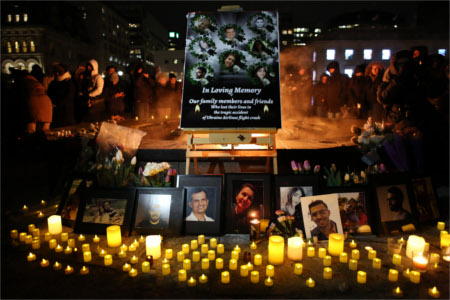
Friends and relatives gather on Parliament Hill in Ottawa, Canada, during a candlelight vigil for the victims who were killed in a plane crash in Iran on Jan. 9. Photo: Dave Chan/Getty Images
by Chad Bouchard
As the New York Times correspondent covering Iran, OPC Governor Farnaz Fassihi has been in extra high gear since before the new year, keeping up with assassinations, attacks, mass protests, the tragedy of a downed jetliner, and volatile Iran-US brinksmanship.
“Iran is a big and significant story both in terms of what is happening inside the country and its standoff with the United States. As an Iranian-American journalist and someone who has covered the story for over 25 years, I feel a responsibility in telling the story accurately and with context and nuance,” Fassihi said in an email.
News from Iran had already heated up in November, when security forces shot and killed up to 600 people who had taken to the streets after a fuel price increase sparked unrest and inflamed calls for ousting the Islamic Republic’s leadership. In December, she broke the news of a mass killing in the southern city of Mahshahr where Iran’s Revolutionary Guards Corps had encircled a group of ethnic Arab men in the marshes and opened fire.
In late December, she wrote that police beefed up security as some people called for renewed protests at the graves of those killed in November. US forces conducted airstrikes on facilities in Syria and Iraq that the Pentagon said were linked to pro-Iran militias, and demonstrators stormed the U.S embassy in Baghdad.
Fassihi’s reporting went into overdrive following the U.S. drone strike near the Baghdad airport on Jan. 3 that killed several high-level officials, including leaders of Iraqi militias backed by Iran and Gen. Qassim Suleimani, the commander in charge of most Iranian intelligence and military operations abroad over the past 20 years.
“Iranian sources in Iran are warning that killing Gen. Qasem Suleimani spells war,” one of her earliest tweets read after the news broke. “Official reaction will begin with a strike,” she quoted one of the sources as saying.
Fassihi tweeted more than 30 times in the first day while the story was developing, sharing confirmation of events from her sources as well as videos, photos and context, all while writing the next-day Times piece that summarized the attack and immediate fallout.
Her reporting was featured on the Times podcast The Daily on Dec. 3 and Jan. 7, when she shed light on the worst violence in Iran for 40 years during the uprising and the impassioned reaction of activists and other supporters, including Supreme Leader Ayatollah Ali Khamenei’s emotional prayer for the dead over Suleimani’s coffin. Among those Fassihi talked with at the funeral was a 22-year old university student. She asked why he attended.
“And he said, knowing General Suleimani was out there made me feel safer. He was like a security umbrella above our country. And that’s a sentiment that I heard over and over,” Fassihi said.
She said there are many Iranians who did not love and respect Suleimani, but added that it was crucial to remember that he was instrumental in the fight against ISIS in Iraq and Syria and “singlehandedly the most revered and influential character in Iran.”
The pace of news surrounding Iran remained relentless in the following days, with the retaliatory missile strikes against U.S. military targets in Iraq, and Ukraine International Airlines Flight 752 getting shot down on Jan. 8 soon after takeoff from Tehran, killing 176 passengers and crew.
Fassihi humanized victims by delving into their lives, posting messages from loved ones and reporting on funerals. She translated a tweet from a Tehran MP who called on Khamenei to “‘take a look at’ the pain and agony of a grieving mother being held back by security forces from attending her son’s burial.”
On Jan. 21, she tweeted “Best line I’ve heard about the impact of Ukrainian Airlines tragedy on Iranians: ‘This flight had 176 dead and 83 million injured.’”
Most recently, Fassihi’s Jan. 26 piece “Anatomy of a Lie” examined what led up to the missile attack against a jetliner, and the immediate cover up that ensued. She wrote that authorities feared admitting the mistake would undermine some of the public support the government had galvanized after Suleimani’s assassination and Iran’s retaliatory missile strikes.
“They advocated covering it up because they thought the country couldn’t handle more crisis,” she quoted a ranking member of the Revolutionary Guards.
